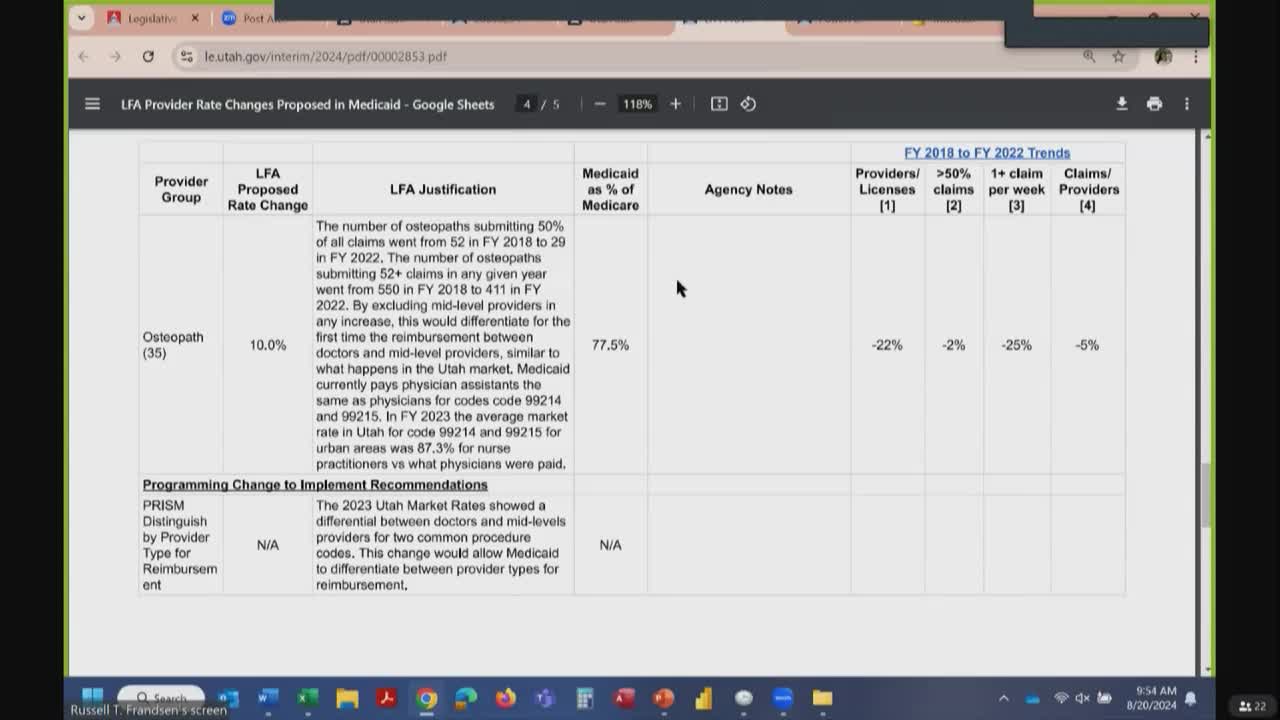Medicaid analysis reveals urgent need for reform
August 20, 2024 | Utah Interim, Utah Legislative Branch, Utah

This article was created by AI summarizing key points discussed. AI makes mistakes, so for full details and context, please refer to the video of the full meeting. Please report any errors so we can fix them. Report an error »

During a recent government meeting, significant discussions centered around the challenges and complexities of Medicaid reimbursement rates and provider access. A key concern raised was the six-month waiting period for services, which many believe exacerbates medical conditions rather than alleviating them. One committee member emphasized the need for a comprehensive study on reimbursement rates to ensure patient access, highlighting the importance of quantifying and qualifying these rates.
The conversation also touched on the difficulties in accurately calculating provider costs. A member expressed skepticism about the reliability of self-reported costs from providers, suggesting that third-party analyses might yield more accurate assessments of both direct and indirect costs associated with service provision. This sentiment was echoed by another representative who cautioned against relying solely on quantitative data without considering qualitative factors that impact patient care and service availability.
The committee reviewed data indicating trends in provider participation in Medicaid, noting a decline in certain categories, such as osteopaths, where participation has decreased by 22% over the past five years. This trend raises concerns about the sustainability of Medicaid services and the potential impact on patient wait times.
Further discussions highlighted the financial implications of Medicaid growth, with the federal government identified as the primary driver of increased state funding for Medicaid from 2014 to 2023. The Affordable Care Act was noted as the costliest mandate, significantly impacting state budgets.
As the meeting progressed, members acknowledged the importance of balancing cost considerations with the need for quality patient care. The chair expressed a commitment to further research on provider costs and the overall impact of Medicaid changes, aiming to provide a clearer picture for future discussions and decisions. The committee plans to continue its examination of these issues, with a focus on ensuring that Medicaid remains accessible and effective for those it serves.
The conversation also touched on the difficulties in accurately calculating provider costs. A member expressed skepticism about the reliability of self-reported costs from providers, suggesting that third-party analyses might yield more accurate assessments of both direct and indirect costs associated with service provision. This sentiment was echoed by another representative who cautioned against relying solely on quantitative data without considering qualitative factors that impact patient care and service availability.
The committee reviewed data indicating trends in provider participation in Medicaid, noting a decline in certain categories, such as osteopaths, where participation has decreased by 22% over the past five years. This trend raises concerns about the sustainability of Medicaid services and the potential impact on patient wait times.
Further discussions highlighted the financial implications of Medicaid growth, with the federal government identified as the primary driver of increased state funding for Medicaid from 2014 to 2023. The Affordable Care Act was noted as the costliest mandate, significantly impacting state budgets.
As the meeting progressed, members acknowledged the importance of balancing cost considerations with the need for quality patient care. The chair expressed a commitment to further research on provider costs and the overall impact of Medicaid changes, aiming to provide a clearer picture for future discussions and decisions. The committee plans to continue its examination of these issues, with a focus on ensuring that Medicaid remains accessible and effective for those it serves.
View full meeting
This article is based on a recent meeting—watch the full video and explore the complete transcript for deeper insights into the discussion.
View full meeting

